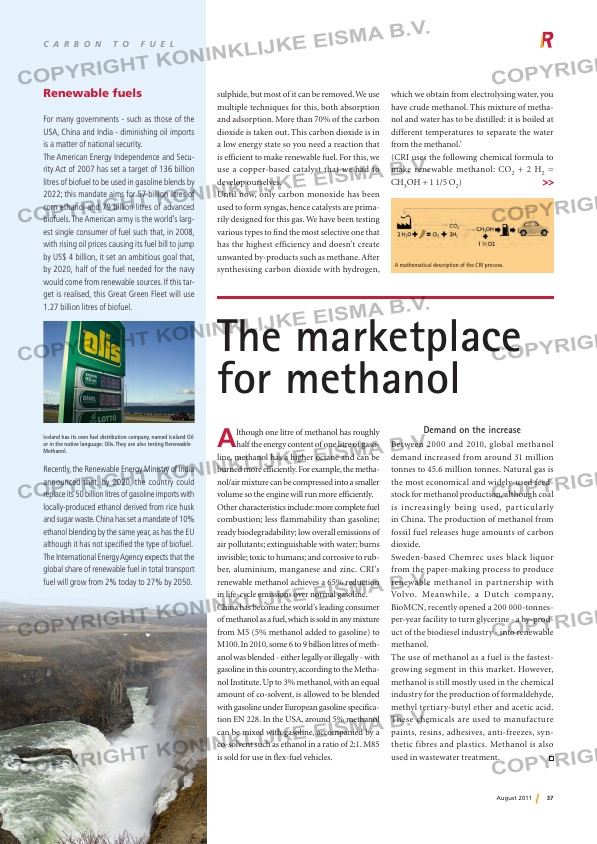Page 37 from: August 2011

37August 2011
sulphide, but most of it can be removed. We use
multiple techniques for this, both absorption
and adsorption. More than 70% of the carbon
dioxide is taken out. This carbon dioxide is in
a low energy state so you need a reaction that
is efficient to make renewable fuel. For this, we
use a copper-based catalyst that we had to
develop ourselves.
Until now, only carbon monoxide has been
used to form syngas, hence catalysts are prima-
rily designed for this gas. We have been testing
various types to find the most selective one that
has the highest efficiency and doesn’t create
unwanted by-products such as methane. After
synthesising carbon dioxide with hydrogen,
which we obtain from electrolysing water, you
have crude methanol. This mixture of metha-
nol and water has to be distilled: it is boiled at
different temperatures to separate the water
from the methanol.’
(CRI uses the following chemical formula to
make renewable methanol: CO2 + 2 H2 =
CH3OH + 1 1/5 O2) >>
Renewable fuels
For many governments – such as those of the
USA, China and India – diminishing oil imports
is a matter of national security.
The American Energy Independence and Secu-
rity Act of 2007 has set a target of 136 billion
litres of biofuel to be used in gasoline blends by
2022; this mandate aims for 57 billion litres of
corn ethanol and 79 billion litres of advanced
biofuels. The American army is the world’s larg-
est single consumer of fuel such that, in 2008,
with rising oil prices causing its fuel bill to jump
by US$ 4 billion, it set an ambitious goal that,
by 2020, half of the fuel needed for the navy
would come from renewable sources. If this tar-
get is realised, this Great Green Fleet will use
1.27 billion litres of biofuel.
Recently, the Renewable Energy Ministry of India
announced that, by 2020, the country could
replace its 50 billion litres of gasoline imports with
locally-produced ethanol derived from rice husk
and sugar waste. China has set a mandate of 10%
ethanol blending by the same year, as has the EU
although it has not specifi ed the type of biofuel.
The International Energy Agency expects that the
global share of renewable fuel in total transport
fuel will grow from 2% today to 27% by 2050.
Although one litre of methanol has roughly half the energy content of one litre of gaso-
line, methanol has a higher octane and can be
burned more efficiently. For example, the metha-
nol/air mixture can be compressed into a smaller
volume so the engine will run more efficiently.
Other characteristics include: more complete fuel
combustion; less flammability than gasoline;
ready biodegradability; low overall emissions of
air pollutants; extinguishable with water; burns
invisible; toxic to humans; and corrosive to rub-
ber, aluminium, manganese and zinc. CRI’s
renewable methanol achieves a 65% reduction
in life-cycle emissions over normal gasoline.
China has become the world’s leading consumer
of methanol as a fuel, which is sold in any mixture
from M5 (5% methanol added to gasoline) to
M100. In 2010, some 6 to 9 billion litres of meth-
anol was blended – either legally or illegally – with
gasoline in this country, according to the Metha-
nol Institute. Up to 3% methanol, with an equal
amount of co-solvent, is allowed to be blended
with gasoline under European gasoline specifica-
tion EN 228. In the USA, around 5% methanol
can be mixed with gasoline, accompanied by a
co-solvent such as ethanol in a ratio of 2:1. M85
is sold for use in flex-fuel vehicles.
Demand on the increase
Between 2000 and 2010, global methanol
demand increased from around 31 million
tonnes to 45.6 million tonnes. Natural gas is
the most economical and widely-used feed-
stock for methanol production, although coal
is increasingly being used, particularly
in China. The production of methanol from
fossil fuel releases huge amounts of carbon
dioxide.
Sweden-based Chemrec uses black liquor
from the paper-making process to produce
renewable methanol in partnership with
Volvo. Meanwhile, a Dutch company,
BioMCN, recently opened a 200 000-tonnes-
per-year facility to turn glycerine – a by-prod-
uct of the biodiesel industry – into renewable
methanol.
The use of methanol as a fuel is the fastest-
growing segment in this market. However,
methanol is still mostly used in the chemical
industry for the production of formaldehyde,
methyl tertiary-butyl ether and acetic acid.
These chemicals are used to manufacture
paints, resins, adhesives, anti-freezes, syn-
thetic fibres and plastics. Methanol is also
used in wastewater treatment.
The marketplace
for methanol
A mathematical description of the CRI process.
Iceland has its own fuel distribution company, named Iceland Oil
or in the native language: Olís. They are also testing Renewable
Methanol.
C A R B O N T O F U E L
p034_CO2 Recycling.indd 37 09-08-11 16:44



